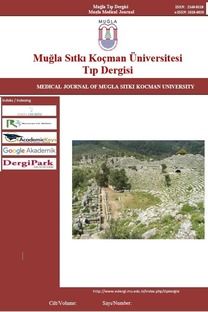Pseudomonas Aeruginosa Suşlarının Direnç Durumunun Yıllar İçindeki Değişimi
Pseudomonas aeruginosa, neden olduğu hastane
infeksiyonlarının yüksek mortalite ve morbiditeye sebep olması nedeniyle önem
kazanmaktadır. Prognoza olumsuz etkilerinin yanı sıra hastanede yatış süresi ve
maliyeti de artırmaktadır. Hastane infeksiyonlarının ampirik tedavi yaklaşımı
için, antibiyotik direnç durumunun bilinmesi önemlidir. Bu çalışmada; hastane
infeksiyonlarına sebep olan klinik örneklerden izole edilmiş P. aeruginosa
suşlarının antibiyotiklere direnç oranları, yıllar içindeki durumunu analiz
etmek ve uygun ampirik antibiyotik kullanım politikalarını belirlenmek
amaçlandı. Çalışmada 2013-2016 yılları arasında, izole edilmiş P.aeruginosa
suşlarının antibiyotiklere duyarlılık durumları retrospektif olarak
değerlendirildi. İzole edilen etkenlerin tanımlanmasında, konvansiyonel ve otomatize identifikasyon
sistemlerinden yararlanıldı. Antibiyotik duyarlılıkları, Clinical and
Laboratory Standards İnstitute (CLSI)
kriterlerine göre, VİTEK 2 otomatize sistemi ile belirlendi. Belirtilen
tarihler arasında 626 P.aeruginosa suşu izole edildi ve değerlendirilmeye
alındı. Bu suşların 91’i hemokültür, 132’si idrar, 340’ü solunum ve 63’ü diğer
örneklerden izole edildi. En düşük direnç oranı, kolistine karşı saptandı
(2016’da %3.97). Yıllar içinde
istatistiksel olarak anlamlı bir değişiklik saptanmadı (p>0.05, Ki-kare
testi). En yüksek direnç oranı 2016 yılında piperasilinde (%61.79) saptanmış
olup, 2013’teki %46.40’lık oranla karşılaştırıldığında istatistiksel olarak
anlamlı yüksek bulundu (p=0.01, Ki-kare testi). Hastane infeksiyonlarının
ampirik tedavisinde etken suşların duyarlılık paternlerinin hastaneden
hastaneye göre farklılık gösterdiği gibi, yıllar içinde de değişiklik
gösterebileceğinden, güncel veriler göz önüne alınmalıdır.
Anahtar Kelimeler:
Antibiyotik Duyarlılığı, Hastane Enfeksiyonları, Pseudomonas Aeruginosa
Change in the Resistance of Pseudomonas Aeruginosa Strains Which Were Isolated, Over the Years
Pseudomonas
aeruginosa is one of the most commonly encountered factors of nosocomial
infections with high mortality and morbidity rates. In addition to its adverse
effects, prognosis increases the length of hospital stay and cost as well. It
is important to know the resistance as part of the empiric treatment approach
to nosocomial infections. This study aimed to analyze the resistance of P.
aeruginosa strains against the antibiotics over the years by using the clinical
samples obtained from the microbiology laboratory, and to determine the proper
policies for empirical antibiotic use. Antibiotic susceptibility of 626 P. aeruginosa
strains which were isolated between 2013 and 2016 was evaluated
retrospectively. Conventional and automated identification systems were used to
identify the isolated factors. Antibiotic susceptibility of the isolates were specified
through VITEK 2 automated system based on the criteria of Clinical and
Laboratory Standards Institute (CLSI). 91, 132 and 340 of 626 isolates were
isolated from hemoculture, urine and airway, respectively. The remaining
strains were isolated from the other samples. The lowest resistance rate
belonged to the resistance against cholistin and no change was observed within
years in this respect. The highest rate of resistance was determined in piperasilin (%61.79) in 2016
and when compered to the rate of 2013,
it was found significant high statically (p=0.01). Updated data should be taken
into consideration as the empirical antibiotic treatment is initiated for P. aeruginosa
strains that can cause nosocomial infections, because susceptibility patterns
of the strains may vary depending on the hospital, years as well.
___
- 1. Kang CI, Kim SH, Park WB, et al. Risk factors for antimicrobial resistance and influence of resistance on mortality in patients with bloodstream infection caused by Pseudomonas aeruginosa. Microb Drug Resist. 2005;11:68-74.
- 2. Rello J, Rue M, Juber P, et al. Survival in patients with nosocomial pneumonia :impact of the severity of illness and the etiologic agent Crit Care Med. 1997;25:1862-17.
- 3. Bou R, Lorente L, Aguilar A, et al. Hospital economic impact of an outbreak of Pseudomonas aeruginosa infections. J Hosp Infect. 2009;71(2):138-42.
- 4. Van Eldere J. Multicentre surveilance of pseudomonas aeruginosa susceptibilty patterns in nosocomial infections. J Antimic Chemotherapy. 2003;51:347-52.
- 5. Livermore DM. Multiple mechanisms of antimicrobial resistance in P. aeruginosa:our worst nightmare? Clin Infect Dis. 2002;34(5):634-40.6.
- 6. Livermore DM. Interplay of impermeability and chromosomal beta-lactamase activity in imipenem resistant P. Aeruginosa. Antimicrob Agents Chemother 1992;36(9):2046-8.
- 7. Durmaz S, Özer TT. Klinik örneklerden izole edilen Pseudomonas aeruginosa suşlarında antibiyotik direnci. Abant Med J. 2015;4(3):239-42.
- 8. Ak S, Fatma Yıldız, Ayten Gündüz, Mehmet Köroğlu. Pseudomonas aeruginosa Suşlarının Antibiyotiklere Duyarlılıklarının Vitek 2 Otomatize Sistemi ile Değerlendirilmesi: GMJ. 2016;27:62-4.
- 9. Karay H, Hammami A, Mahjoubi F, Bouaziz M, Damak J, Jeddi HM. In vitro study of the sensitivity to antibiotics of 213 P.aeruginosa strains isolated in an intensive care unit of Sfax Hospital Pathol Biol. 1993;41(4):307-12.
- 10. Öztürk CE. Pseudomonas aerugunosa suşlarında antibiyotik direnç ve beta-laktamaz oranları. ANKEM Derg. 2010;24(3):117-23.
- 11. Yates RR. New intervention strategies for reducing antibiotic resistance. Chest. 1999;115 (Suppl 3):24-7.
- 12. Geissler A, Gerbeaux P, Granier I, et al. Rational use of antibiotics in the intensive care unit: impact on microbial resistance and costs. Intensive Care Med. 2003;29(1):49-54.
- 13. Micek ST, Ward S, Fraser VJ, Kollef MH. A randomized controlled trial of an antibiotic discontinuation policy for clinically suspected ventilator-associated pneumonia, Chest. 2004;125(5):1791-9.
- 14. Kollef MH. Is there a role for antibiotic cycling in the intensive care unit? Crit Care Med. 2001;29(Suppl 4):N135-42.
- 15. Cunha BA. Antibiotic resistance. Control strategies. Crit Care Clin. 1998;14(2):309-27.
- 16. Cunha BA. Effective antibiotic-resistance control strategies, Lancet. 2001;357(9265):1307-8.
- ISSN: 2148-8118
- Yayın Aralığı: Yılda 3 Sayı
- Başlangıç: 2014
- Yayıncı: Muğla Sıtkı Koçman Üniversitesi
Sayıdaki Diğer Makaleler
Virjin Hastada Vajenden Doğmuş Endometriyal Polip: Bir Olgu Sunumu
Buğra ŞAHİN, Gizem CURA, Fatih ÇELİK, Banuhan ŞAHİN
Mustafa KESTEL, Hüseyin TARHAN, Hayrettin ŞAHİN
Gerçek Dirençli Epilepsi Mi? Üçüncü Basamak Merkezde Hastaların Takibi
Hiperbarik Oksijen Tedavisine Bağlı Ortaya Çıktığı Düşünülen Psikotik Bozukluk Olgusu
Serdar BULUT, Süheyla DOĞAN BULUT, Serkan DİLMEN
Pseudomonas Aeruginosa Suşlarının Direnç Durumunun Yıllar İçindeki Değişimi
Oktay YAPICI, Alper AKGÜNEŞ, Senem AKGÜL, Bora EKİNCİ, Nilüfer SAYGILI PEKİNTÜRK
Blue Toe Sendromu ile Ortaya Çıkan Yüzeyel Femoral Arterin İzole Gerçek Sakküler Anevrizması
Burak Can DEPBOYLU, Serkan YAZMAN, Buğra HARMANDAR, Serkan Yaşar ÇELİK
